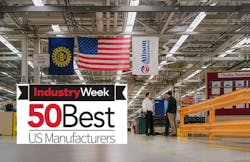IW U.S. 50 Best Manufacturers: Allison Transmission Tops List
To hear Chairman and CEO David Graziosi explain it, market conditions just favored Allison Transmission last year, driving it to record earnings.
“Unprecedented demand for Class 8 vocational vehicles persisted in the fourth quarter of 2024, leading to record full year net sales,” Graziosi says in describing the company’s earnings. Other factors included higher defense industry sales and record numbers for commercial truck equipment sales outside of North America.
Yet Allison had a great year in 2023 without those factors. And, it reported great numbers in 2022 and 2021 as well. Put simply, Allison has outperformed most of its peers in the automotive industry and the larger manufacturing world for several years, a streak of good management that led to landing No. 1 on the 2025 IndustryWeek 50 Best U.S. Manufacturers list.
Drawn from the IndustryWeek U.S. 500 list of America’s largest publicly traded manufacturers, the 50 Best Manufacturers list applies a series of financial and operational metrics to determine which companies return the best results to investors while investing in their own futures (details on the methodology are in the sidebar attached to this article).
Calculating the List
Using data from S&P Global Market Intelligence, we evaluated members of the IndustryWeek U.S. 500 list of the largest publicly traded manufacturing companies in the country using six metrics:
- Revenue Growth, Net Income Growth: For each of those metrics, we pulled annual results for the past four years to calculate percentage change for the past three years and ranked companies on growth. We assigned a 1-10 score based on where companies fell on the IW 500 for each of the three years and added those figures together, weighting scores at 60% for the most recent year, 25% for the previous year and 15% for results from three years ago.
- Inventory Turnover: A measure of how efficiently a company produces, sells and replaces stock, S&P calculates this figure by comparing how many times a company sold its inventory to its costs-of-goods-sold. A low turnover value implies that a company is overstocking material or has poor sales, while a high number indicates a company in state of flow, constantly producing, selling and restocking. Using S&P turnover data, we ranked three years of data to generate and weight scores in the same way that we did for revenue and net income.
- Net Income Margin: A simple calculation of net income-to-sales, this measures how much a company earns for each sale made. We then ranked, scored and weighted the results using the same formula as the previous four metrics.
- Return on Assets, Return on Equity: RoA measures a company’s net income by its assets, measuring how efficiently it uses its investments in fixed costs such as factories and distribution centers. RoE measures net income in relation to shareholder equity (company assets minus debt), determining how much wealth it generates for those who own stock. We ranked and scored companies for their past five years of performance on these two metrics, weighting results at 50% for the most recent year, 20% for the previous year, 15% for three years ago, 10% for four years ago and 5% for five years ago.
We then added the weighted scores from each of those categories into a final score that we ranked to determine the top 50 performers. Using a variety of metrics and measuring companies by how they ranked on our list of 500 candidates prevented companies that excelled in a single category from dominating the list.
As is typical with the list, the top company didn’t excel in every metric, but it performed well across the board. Allison’s only top ranking in the 2025 measurements was its return on equity, a basic measure of how much value the company generates for those who own shares of its stock. It also scored well on profit margin growth and its management of its assets.
The No. 1 placement for 2025 caps off a strong, multi-year run for Allison in this measure of financial management excellence. It ranked No. 2 last year, No. 34 in 2023 and No. 41 in 2022.
New Faces on the List
Editors generate the IndustryWeek 50 Best U.S. Manufacturers by collecting five years of performance data on companies. While we weight the most recent year most heavily, the need for solid performance throughout several years keeps the list free of companies that have one really good year. Still, the makeup changes every year as some companies get past a weak performance from several years ago or when performance improves across the board.
Then, there are the companies that have been well run for many years, but they were too small to appear on the IW 500 list. Armstrong World Industries Inc., a Pennsylvania building supplies company that engineers ceilings and makes acoustic tiles for schools, office buildings and airports, falls into that category. In 2023, the company had $1.3 billion in sales. The smallest company on the 2024 IW 500 had $1.44 billion in revenue in 2023.
Last year, Armstrong had $1.45 billion in revenue, making it No. 456 on the 2025 IW 500, and its impressive financial performance throughout the past five years made it No. 2 on the 50 Best Manufacturers list.
CEO Vic Grizzle says about a decade ago, the company embraced a philosophy of being a champion of stability in its industry, focused on being a reliable supplier to its customers and a great employer. At the same time, leadership focused on adaptability, selling off its European and Asian divisions and divesting its flooring business to focus on being the best North American ceiling systems provider it could be. That meant buying some competitors and branching into adjacent markets in recent years.
“You don’t get to last to be 160 years unless you’re willing adapt and change,” Grizzle says. “This company went through bankruptcy, by the way, through the asbestos bankruptcies in the early 2000s, so it has an ability to adapt.”
Grizzle attributes much of Armstrong’s growth strategy to a 2012 Harvard Business Journal article by Columbia University Professor Rita McGrath, a consultant and author of “The End of Competitive Advantage” in 2013 and “Seeing Around Corners” in 2019. Her 2012 article focused on outliers, companies that had been able to maintain 5% growth for five consecutive years. There aren’t many of them.
[Editor’s Note: Come back on July 1 for more information about Armstrong and McGrath’s opinions about long-term financial and operational excellence in manufacturing.]
Smaller Companies Added to the 50 Best
Other companies that were too small in 2024 to make that list but were big enough in 2025 were:
- Lantheus Holdings Inc. – radioactive dyes for imaging tests and other cancer screening technologies
- No. 447, IW 500
- No. 6, IW 50
- Blue Bird Corp. – school buses
- No. 467, IW 500
- No. 27, IW 50
- AAON Inc. – commercial heating, ventilation and air conditioning equipment
- No. 482, IW 500
- No. 42, IW 50
- National Beverage Corp. – La Croix, Shasta and Faygo soft drink brands
- No 486, IW 500
- No. 9, IW 50
- Trex Co. Inc. – composite materials for home decks and other applications. Trex appeared No. 6 in the 2022 IW 50, but fell off the IW U.S. 500 in 2023 and 2024.
- No 489, IW 500
- No. 30, IW 50
- Cactus Inc. – wellhead equipment for the energy industry
- No. 493, IW 500
- No. 50, IW 50
When asked about Armstrong’s embrace of her research, McGrath says combining stability and adaptability is critical.
“Outlier firms provided a stable core of things their people could count on. Their strategies (and corporate purposes) didn’t change much during a turbulent period that included the dot-com bubble bursting, the tragedy of 9/11, the introduction of the euro and the Great Recession of 2008,” McGrath says. “They tended to promote from within, meaning that their leadership had built extensive social networks within the company, were carriers of its culture and stuck around. They spend a lot of time and communication on culture and shared values.”
She adds that the cultural component is key to driving innovation and adaptability.
“If you know and trust your leadership, if the culture rewards accountability and transparency and if you are given opportunities to try new things and grow both as a person and a company without fear of retaliation or punishment, you are much less likely to behave in a political, risk-averse, zero-sum way,” McGrath says.
Overall Performance
We call this group the 50 Best Manufacturers because they consistently turn in good numbers for revenue growth, net income growth, margins, inventory controls and other metrics. So, it’s not a huge surprise that it outperformed the IW U.S. 500 list, financially.
Combined, revenues for the group were up 8.45% and net income was up just over 8%. For the 500 largest publicly traded manufacturers, revenues were up less than 1% and net income plunged nearly 13% (you can read all about that in our analysis of the IW U.S. 500).
However, the 50 Best Manufacturers list is dynamic, changing significantly every year as companies’ performances shift. The 2025 list features fewer giant manufacturers than in years past. The average IW 50 company this year had $16.7 billion in revenue, down from $20.2 billion on the 2024 list. Massive companies such as Valero Energy, Tesla, Caterpillar and Deere & Co. populated the 2024 list but failed to make it this year for various performance reasons.
Of the 50, 21 companies made the 2024 best list as well, a fairly typical level of turnover for the assessment. The largest company on the list in 2025 was PepsiCo. (No. 10 for the IW 500, No. 33 for the IW 50). The smallest was Cactus Inc. (No. 493 on the IW 500, No. 50 on the IW 50).
About the Author
Robert Schoenberger
Editor-in-Chief
LinkedIn: linkedin.com/in/robert-schoenberger-4326b810
Bio: Robert Schoenberger has been writing about manufacturing technology in one form or another since the late 1990s. He began his career in newspapers in South Texas and has worked for The Clarion-Ledger in Jackson, Mississippi; The Courier-Journal in Louisville, Kentucky; and The Plain Dealer in Cleveland where he spent more than six years as the automotive reporter. In 2014, he launched Today's Motor Vehicles (now EV Manufacturing & Design), a magazine focusing on design and manufacturing topics within the automotive and commercial truck worlds. He joined IndustryWeek in late 2021.

